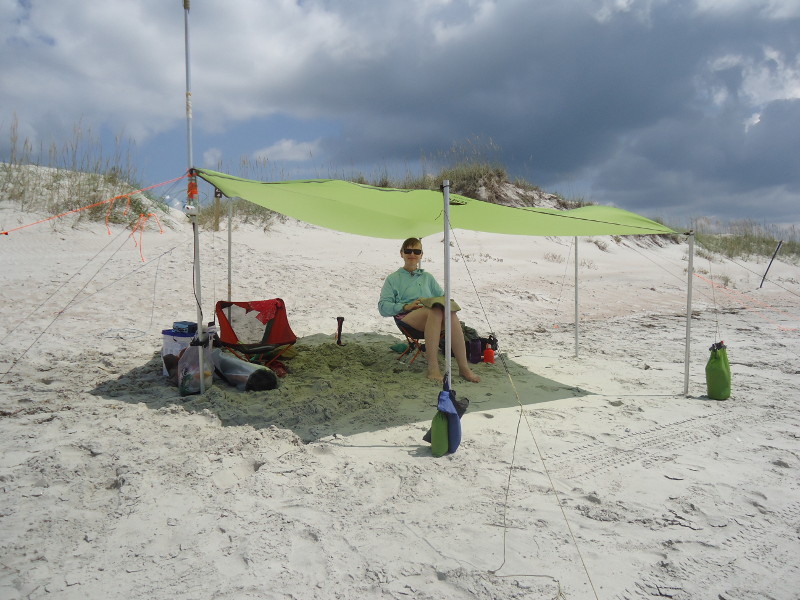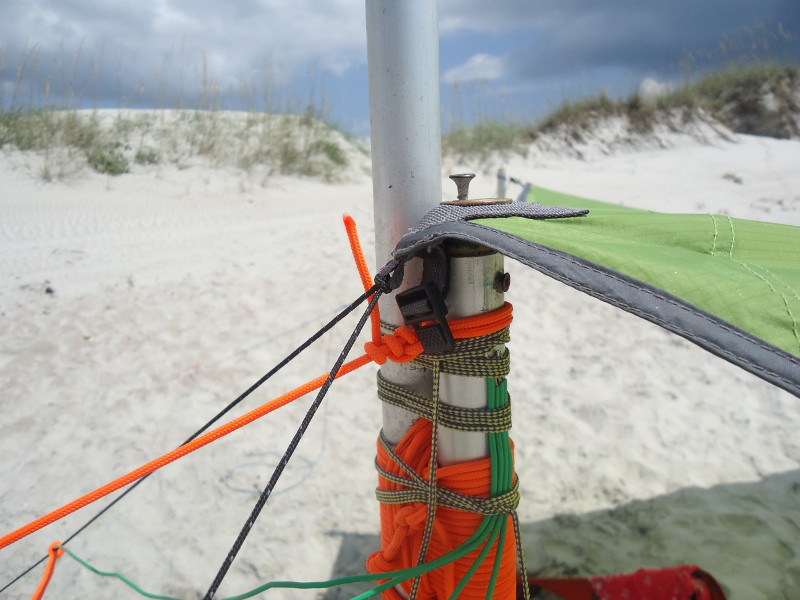29 — Bear Island Knots, Hitches, and Loops.
2015-07-19. By Patrick.

Fig. 1. Images are from our 2015-07 Bear Island trip. Here, Kelly sitting under our tarp. The camp is just behind the dunes to the left, the ocean just off-image to the right. Many guy lines can be seen holding the poles in place and sand bags holding them down against the wind. The undulations in the tarp are from the wind. At left, some lashings can be seen (orange) holding our antenna up. Also, black guy line in the foreground was extended with a yellowish one. The connection between the two can be adjusted using either line because the connection is made by two loops both of which use taut-line hitches.
Knots are fun to learn. But what do I really use? We just spent week on Bear Island. That was long enough and included enough different settings that I needed to use pretty much every knot that would ever use.
First a bit of background. From where did I get my knowledge of knots? The earliest knots I definitely learned in the scouts in France. Although I learned quite a few, there were definitely some that became ingrained in my mind because of repeated use. At the top of the list, I would place the half-hitches, clove hitch, taut-line hitch, and the square lashing. After this I learned some in the US scouts, mostly from instruction. But no new ones that I would use routinely. I did learn some new ones when I got interested in sailing. Those were all from books. Many of them were not related to sailing. Two of these new ones that get used routinely are the versatacle and Ashley's stopper. And more recently I learned a new set when Kelly got us into rock climbing.
So what did we end up using in a single week of camping at bear Island. The taut-line hitch was used all the time. I tie it two ways when not careful; I'm not sure which way is the correct way and I realized on this trip that I don't care any more. I hate those plastic things they put on tent guy lines. The clove hitch was used all the time. And the bowline. And half hitches off course. The versatacle got used at the start and end of the trip to lash the canoe to the top of the car. I used several lashings to hold together folded up tarps and tents. I used a straight lashing on two poles to get an antenna up. I used the alpine butterfly a couple times. The most surprising use was the icicle hitch. I had always thought that it was fun to know about because of its incredible holding power but I had believed that it would never actually be needed; just another fun 'academic' knot. But in the middle of a night-time thunderstorm with the wind howling and the rain coming sideways, the clove hitches on the wet aluminum poles were sliding down. Every twenty minutes or so the giant tarp over our sitting and cooking area was pushing down on everything with a puddle forming in the center. So I tried the icicle hitch. And sure enough, it stayed put the rest of the night. Cool.
There were some notable absences. Pole cross lashings that I used to use all the time were not used on this trip. And of course, none of the climbing knots were used.
So my premise was mistaken. I don't think there will ever be a trip during which I will end up using every knot that I find practical. Some knots have a purpose that is just too specific.

Fig. 2. Close-up of the lashing area. At top two sets of guy lines can be seen. The black ones are made from a single line attached directly to the tarp with a clove hitch. Below that, a single orange guy line is attached to the pole with a clove hitch and three half-hitches. These went on first. Next, two lashings (black-yellow thin string at top, orange string below) were used to secure the antenna top pole to the bottom pole. The top lashing serves a second purpose to fasten the electrical wires (green) for the antenna and it's ground system. At the top of the green wires, a bit of the bare wire can be seen being pressed against the aluminium pole to make the electrical contact. At left, one of the electrical wires making up the ground system can be seen to be pull-out to one of the black guy lines and fastened with some orange string (probably using double over-hand knot).